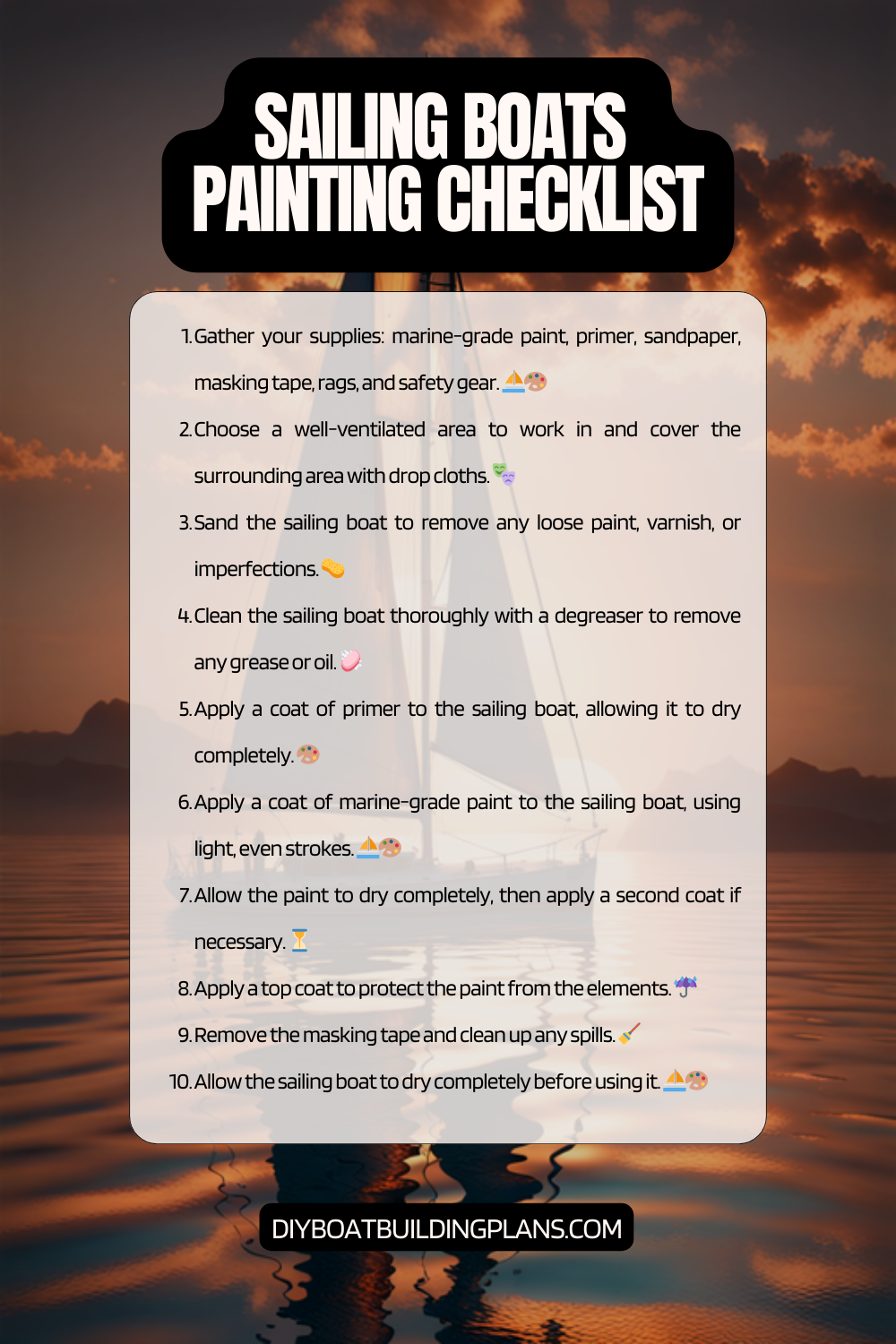Overview of Sailing Boat Painting Tips
Sailing boats are not only a means of transportation but also a symbol of freedom and adventure. However, over time, the exterior of a sailing boat can become worn and faded due to exposure to the elements. Painting your sailing boat can not only restore its beauty but also protect it from further damage. In this article, we will explore various tips and techniques for painting your sailing boat, ensuring a professional finish that will last for years to come.
Key Takeaways
- Choose the right paint for your sailing boat based on the type of material and conditions it will face.
- Properly prepare your sailing boat for painting by cleaning, sanding, and masking off areas.
- Use sanding techniques to achieve a smooth finish before applying primer and paint.
- Masking and taping can help create clean lines and prevent paint from getting on unwanted areas.
- Applying a clear coat can protect your newly painted sailing boat and regular maintenance is key to keeping it looking great.

Choosing the Right Paint for Your Sailing Boat
When it comes to painting your sailing boat, choosing the right type of paint is crucial. There are several options available, including marine enamel, polyurethane, and epoxy paints. Marine enamel is a popular choice due to its durability and affordability. Polyurethane paints offer excellent UV resistance and are known for their high gloss finish. Epoxy paints provide superior protection against water intrusion and are often used for below-the-waterline applications.
When selecting the paint for your sailing boat, there are several factors to consider. Firstly, you need to determine whether you will be painting above or below the waterline. Different paints are designed for each area, as those below the waterline require antifouling properties to prevent marine growth. Secondly, consider the climate in which your boat will be sailing. If you frequently sail in hot and sunny conditions, UV resistance should be a priority. Lastly, think about the desired finish and color scheme for your boat. Some paints offer a range of colors and finishes, allowing you to customize your sailing boat’s appearance.
Preparing Your Sailing Boat for Painting
Before you begin painting your sailing boat, it is essential to thoroughly clean the surface to ensure proper adhesion of the paint. Start by removing any loose or flaking paint using a scraper or wire brush. Next, wash the boat with a mild detergent and water to remove dirt, grime, and salt residue. Use a sponge or soft brush to scrub the surface gently. Rinse thoroughly and allow the boat to dry completely before proceeding to the next step.
Inspect your sailing boat for any damages that need to be repaired before painting. Look for cracks, dents, or holes in the hull, deck, or interior surfaces. Use an appropriate filler or epoxy to repair these damages, following the manufacturer’s instructions. Once the repairs are complete, sand the repaired areas to ensure a smooth and even surface.
Sanding Techniques for a Smooth Finish
| Hand Sanding | Sanding by hand using sandpaper or sanding blocks. | Controlled sanding, good for small areas, inexpensive. | Time-consuming, can cause uneven sanding, can be tiring. |
| Power Sanding | Sanding using a power tool such as an orbital sander or belt sander. | Efficient, saves time, good for large areas. | Can be expensive, can cause damage if not used properly, can be noisy. |
| Wet Sanding | Sanding using water to lubricate the sandpaper and reduce dust. | Produces a smooth finish, reduces dust, good for finishing coats. | Can be messy, requires more time and effort, can cause rust if not dried properly. |
| Dry Sanding | Sanding without water or lubrication. | Good for rough sanding, can be done quickly, less messy. | Produces more dust, can cause scratches, not suitable for finishing coats. |
Sanding is a crucial step in achieving a smooth and professional finish on your sailing boat. To get started, gather the necessary tools, including sandpaper of various grits (ranging from coarse to fine), sanding blocks or pads, and a random orbital sander for larger areas. Additionally, consider using a dust mask and safety goggles to protect yourself from airborne particles.
Begin by sanding the entire surface of your sailing boat using coarse-grit sandpaper. This will help remove any remaining paint, smooth out imperfections, and create a rough surface for better paint adhesion. Gradually progress to finer grits of sandpaper, ensuring each previous grit’s scratches are smoothed out before moving on. Pay extra attention to corners and edges, as these areas can be easily missed. Once you have achieved a smooth surface, wipe away any dust using a clean cloth or tack cloth before proceeding to the next step.
Masking and Taping for Clean Lines
To achieve clean lines and prevent paint from bleeding onto unwanted areas, masking and taping are essential techniques in boat painting. Gather materials such as painter’s tape, plastic sheeting or drop cloths, and masking paper or newspaper.
Start by covering any areas you do not want to paint, such as windows, hardware, or trim, with plastic sheeting or drop cloths. Secure the sheeting in place using painter’s tape. Next, use painter’s tape to create clean lines and edges on the areas you intend to paint. Apply the tape carefully, ensuring it adheres firmly to the surface. Use masking paper or newspaper to cover larger areas that need protection. Take your time during this step to ensure precise masking and taping, as it will greatly contribute to the overall quality of your paint job.
Applying Primer to Your Sailing Boat
Priming your sailing boat before applying the final coat of paint is crucial for several reasons. Firstly, primer enhances paint adhesion, ensuring a long-lasting finish. It also helps seal the surface, preventing moisture intrusion and protecting against corrosion. Additionally, primer can help hide imperfections and create a smooth base for the topcoat.
Before applying primer, make sure the surface is clean and dry. Stir the primer thoroughly to ensure proper consistency and even distribution of pigments. Using a brush or roller, apply a thin and even coat of primer to the entire surface of your sailing boat. Allow the primer to dry according to the manufacturer’s instructions before proceeding with the next steps.
Tips for Painting the Hull of Your Sailing Boat
Painting the hull of your sailing boat requires careful attention to detail and proper technique. Start by applying a thin and even coat of paint using a brush or roller. Work in small sections, overlapping each stroke slightly to ensure even coverage. Avoid overloading the brush or roller with paint, as this can lead to drips and uneven application. For a smoother finish, lightly sand between coats using fine-grit sandpaper. Apply multiple coats as necessary, allowing each coat to dry completely before applying the next.
To achieve a professional finish on the hull of your sailing boat, consider the following tips. Firstly, choose a calm and dry day for painting to minimize dust and debris in the air. Secondly, maintain a consistent painting technique throughout the process, ensuring even strokes and coverage. Thirdly, be patient and allow each coat to dry thoroughly before proceeding to the next. Lastly, pay attention to the manufacturer’s recommended drying times and temperature ranges for optimal results.
Painting the Deck of Your Sailing Boat
Painting the deck of your sailing boat requires careful preparation and technique. Start by cleaning the deck thoroughly, removing any dirt, grease, or old paint using a mild detergent and water. Rinse well and allow it to dry completely. Apply painter’s tape to protect areas you do not want to paint, such as hardware or non-skid surfaces. Using a brush or roller, apply a thin and even coat of paint to the deck, working in small sections. Allow each coat to dry before applying additional coats as needed.
To ensure a long-lasting finish on your sailing boat’s deck, consider these tips. Firstly, choose a paint specifically designed for marine decks, as they offer excellent durability and resistance to foot traffic. Secondly, apply multiple thin coats rather than one thick coat to achieve better adhesion and longevity. Thirdly, avoid painting in direct sunlight or extreme temperatures, as this can affect the paint’s drying time and overall performance. Lastly, consider adding a non-skid additive to the paint for improved safety and traction on the deck.
Painting the Mast and Rigging of Your Sailing Boat
Painting the mast and rigging of your sailing boat requires a different approach compared to other areas. Start by thoroughly cleaning the mast and rigging using a mild detergent and water. Rinse well and allow them to dry completely. Next, use painter’s tape and plastic sheeting to protect any areas you do not want to paint, such as hardware or connectors. Apply a thin and even coat of paint using a brush or spray gun, working from top to bottom. Allow each coat to dry before applying additional coats as needed.
Download over 500 Boat Plans. Click on the link below.
-->Click Here<--
When painting the mast and rigging of your sailing boat, safety should be a top priority. Firstly, ensure you have a stable and secure platform from which to work, such as a sturdy ladder or scaffolding. Secondly, use appropriate safety equipment, including gloves, safety goggles, and a dust mask. Thirdly, take extra care when working with spray guns or aerosol paints to avoid overspray or inhalation of fumes. Lastly, follow the manufacturer’s instructions regarding drying times and any additional steps required for optimal results.
Painting the Interior of Your Sailing Boat
Painting the interior of your sailing boat can transform its appearance and create a comfortable and stylish living space. Start by removing any furniture or fixtures that can be easily taken out. Thoroughly clean the interior surfaces using a mild detergent and water, removing any dirt or grease. Repair any damages or imperfections using an appropriate filler or epoxy, sanding them smooth once dry. Apply painter’s tape to protect areas you do not want to paint, such as windows or hardware. Using a brush or roller, apply a thin and even coat of paint to the interior surfaces, working in small sections. Allow each coat to dry before applying additional coats as needed.
To achieve a comfortable and stylish finish on the interior of your sailing boat, consider these tips. Firstly, choose paint colors that complement the overall design and theme of your boat. Lighter colors can create a sense of spaciousness, while darker colors can add warmth and coziness. Secondly, consider using low VOC (volatile organic compounds) or eco-friendly paints to minimize harmful emissions and odors. Thirdly, take your time during the preparation and painting process to ensure a smooth and even finish. Lastly, allow the paint to cure fully before reinstalling any furniture or fixtures to avoid damage or smudging.
Applying a Clear Coat to Protect Your Sailing Boat
Applying a clear coat to your sailing boat after painting is essential for protecting the underlying paint and providing additional durability. Clear coats act as a barrier against UV rays, saltwater, and other environmental factors that can cause paint degradation. They also enhance the gloss and shine of the paint, giving your sailing boat a polished and professional appearance.
Before applying the clear coat, ensure the painted surface is clean and dry. Stir the clear coat thoroughly to ensure proper consistency and even distribution of additives. Using a brush or spray gun, apply a thin and even coat of clear coat to the entire surface of your sailing boat. Work in small sections, overlapping each stroke slightly to ensure even coverage. Allow the clear coat to dry according to the manufacturer’s instructions before applying additional coats if desired.
Maintenance Tips for Your Newly Painted Sailing Boat
To keep your newly painted sailing boat looking its best, regular cleaning and maintenance are essential. Create a cleaning schedule that includes washing the exterior with mild detergent and water regularly to remove dirt, salt residue, and other contaminants. Additionally, inspect the painted surfaces for any signs of damage or wear and address them promptly to prevent further deterioration. Consider applying a wax or polish to the painted surfaces periodically to enhance their shine and protect against UV rays.
To ensure long-term protection of your newly painted sailing boat, consider these tips. Firstly, avoid using abrasive cleaners or harsh chemicals that can damage the paint. Instead, opt for mild detergents or specialized boat cleaning products. Secondly, store your sailing boat in a covered area or use a boat cover when not in use to protect it from the elements. Thirdly, avoid dragging or scraping the boat against rough surfaces that can scratch or chip the paint. Lastly, consider applying a sacrificial anode or antifouling paint below the waterline to protect against corrosion and marine growth.
Sailing Boat Painting Checklist

Conclusion – Sailing Boat Painting Tips
In conclusion, painting your sailing boat can be a rewarding and transformative project that enhances its appearance and protects it from the elements. By choosing the right paint, preparing the surface properly, and employing the right techniques, you can achieve a professional finish that will last for years to come. Whether you are painting the hull, deck, mast, rigging, or interior of your sailing boat, following these tips and techniques will ensure a comfortable, stylish, and well-protected vessel. So don’t hesitate to embark on this exciting painting project and give your sailing boat a fresh new look!
FAQs – Sailing Boat Painting Tips
What are some tips for painting a sailing boat?
Some tips for painting a sailing boat include choosing the right type of paint, preparing the surface properly, using a primer, applying multiple thin coats, and allowing sufficient drying time between coats.
What type of paint should be used for a sailing boat?
Marine-grade paint should be used for a sailing boat. This type of paint is specifically designed to withstand the harsh marine environment, including exposure to saltwater, UV rays, and extreme weather conditions.
How should the surface of a sailing boat be prepared before painting?
The surface of a sailing boat should be thoroughly cleaned and sanded before painting. Any existing paint or varnish should be removed, and any cracks or holes should be filled with an appropriate filler. The surface should then be sanded to create a smooth, even surface for painting.
Why is it important to use a primer when painting a sailing boat?
Using a primer helps to create a strong bond between the paint and the surface of the sailing boat. It also helps to prevent the paint from peeling or chipping over time. A primer also helps to create a smooth, even surface for the paint to adhere to.
How many coats of paint should be applied to a sailing boat?
Multiple thin coats of paint should be applied to a sailing boat, rather than one thick coat. This helps to ensure that the paint dries evenly and doesn’t run or drip. The number of coats required will depend on the type of paint being used and the condition of the surface being painted.
How long should the paint be allowed to dry between coats?
The paint should be allowed to dry completely between coats, which typically takes several hours to overnight. It’s important to follow the manufacturer’s instructions for drying time, as this can vary depending on the type of paint being used and the weather conditions.



